- Between 2000-19, over 750 million people in India gained access to electricity. However India is still the world’s 2nd largest consumer of coal after China.
- India’s current power sector outlook is heavily dependent on thermal power. Of the installed power capacity, thermal comprises 63 percent of which 86.2 percent consists of power obtained from coal.
- India has made considerable progress to improve energy efficiency and has avoided an additional 15% of annual energy demand and 300 million tonnes of CO2 emissions between 2000-18.
- There needs to be better planning of the grid ecosystem where infrastructure is being set up. If the grid already exists, then the option of large scale energy storage needs to be created.
The Indian energy landscape has been evolving over the last 5 years. Since 2015, India has brought about various initiatives to redefine the sustainable energy landscape. India is the world’s third largest energy consumer, accounting for around 5.5 percent of the world’s energy consumption. The country made considerable progress in recent years towards achieving universal access to modern energy, including clean fuel for cooking and electricity, affordable and secure energy for its citizens. The Central Electricity Report (CER) captures effectively the progress (SDG) 7. The report also highlights the persisting challenges that need to be addressed in the coming years.
Challenges for India
How India is currently meeting its energy demands
Between 2000-19, over 750 million people in India gained access to electricity. However India is still the world’s 2nd largest consumer of coal after China. According to data by the International Energy Association (IEA), India’s coal demand had far outpaced any other energy usage. Coal India, which is the state-owned miner, has been under constant pressure to increase its coal production to reduce dependence on imports. India’s energy demands is one of the main reasons for the over-reliance on coal and to reduce this dependence, India needs to increase access to renewables and diversify its total power mix. However, on the positive side, India mined 241 million tonnes of coal in 2018 which is 6 percent less than its production in the corresponding period last financial year.
Power sector outlook – Current scenario and future landscape
India’s current power sector outlook is heavily dependent on thermal power. Of the installed power capacity, thermal comprises 63 percent of which 86.2 percent consists of power obtained from coal. The charts below highlights India’s current power sector outlook according to data by the Ministry of Power.
As you can see from the data points above, the government has set goals that are quite ambitious in nature: an increase in more than twice the installed capacity in renewables by 2022 as well as a generation of 100 GW from solar power, 60 GW from wind power, 10 GW from bio-power and 5 GW from small hydro-power. India is thus clearly moving away from its thermal generating capacity and diversifying its renewable energy mix.
India’s projected power sector mix based on policy recommendations
India has made considerable progress to improve energy efficiency and has avoided an additional 15% of annual energy demand and 300 million tonnes of CO2 emissions between 2000-18 as per the analysis of International Energy Association (IEA).
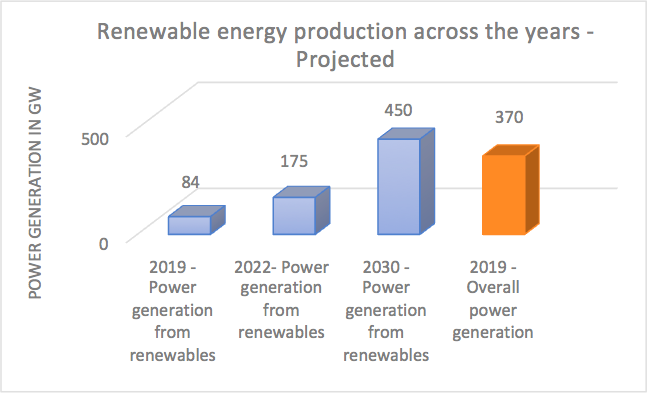
Figure 2 – Data derived from Niti Aayog
With the current policy framework which has improved the energy access to the citizens, India is seeking to increase its energy generation capabilities. India’s investment in solar PV was greater than the investment in all the sources of fossil fuel put together. As of December 2019, India had deployed a total of 84 GW of renewable electricity connected to the grid and the country’s total energy generating capacity reached 366 GW in 2019. India’s current policy framework is thereby enabling it to reach its target of 175 GW of renewables by 2022, and an ambitious goal of reaching 450 GW of renewable energy capacity is being envisioned. The illustration below highlights how the renewable energy production is projected to look like.
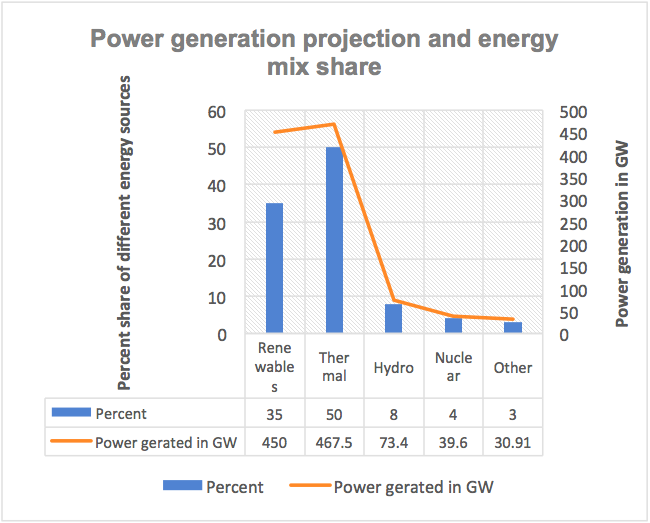
Figure 3 – Data derived from Niti Aayog
As you can see from the chart, by 2030, the energy generated from renewables itself will be more than the overall power generation for 2019.
Further, the projected energy mix for 2030 is highlighted in the second chart along with the percentage split of different power generation sources.
Thus, we can see that our current policy framework and power generation capacities, will lead to the exponential rise of renewables. However, half of our energy needs will still be met by thermal power.
The power distribution challenge
Transmission infrastructure and last-mile connectivity is a major challenge for India. Although, solar and wind energy are renewable sources, they do not promise a constant stream of available power. For renewables to become a major energy source, energy storage will be extremely important.
To begin with, there needs to be better planning of the grid ecosystem where infrastructure is being set up. If the grid already exists, then the option of large scale energy storage needs to be created. This can happen through:
Onboarding utilities companies to enhance the deployment of solar rooftop Photovoltaics (PV’s).
Inducing healthy competition amongst states to ensure that the rooftop PV deployment targets are met (Jawaharlal Nehru National Solar Mission)
Targeting residential consumers to adopt the use of PV’s and bridge the trust deficit arising from bureaucratic red tape.
Developing power transmission network and Green Energy Corridors.
Digitising utilities operations moving forward.
India relies on Renewable Purchase Obligations (RPOs), Renewable Electricity Certificates (RECs), accelerated depreciation of renewable energy assets for commercial and industrial users, as well as competitive tenders. The RPOs require Distribution Companies (DISCOMs), energy producers and certain consumers to obtain a portion of their electricity from renewable sources. Determination of RPO requirements and compliance monitoring is carried out by the State Electricity Regulatory Commissions.
In June 2018 the RPO requirement was raised from 17 to 22 percent in alignment with the goal of achieving 450 GW of power from renewables by 2030. The RECs are used by the obligated entities to meet their RPO requirements.
Through a simple illustration below, I will sum up the factors which will be enablers to address the power distribution challenge.

India has set optimistic goals for itself through various policy initiatives, investing in infrastructure and heavy push for power generation through renewables. India’s demand for alternative fuel sources too is expected to rise with various states drafting Electric Vehicle (EV) policies. With India’s current GDP growth, rise in urbanisation and population growth, rethinking of the ecosystem is paramount for meeting the set goals. Grid technology tenders, achieving parity in pricing of storage technologies through economies of scale and state level policies to give a push to the solar sector will be key towards the transition towards renewables.
Thus, we can see from the data that India will require extensive power generation in the upcoming years, and we have the ability to generate surplus power to meet our needs. What will be interesting to see is the decoupling of the energy landscape from thermal power and then see if we can meet our needs majorly through renewables. Goals and measures have been identified, but whether they can be achieved as per the set targets remains to be seen.

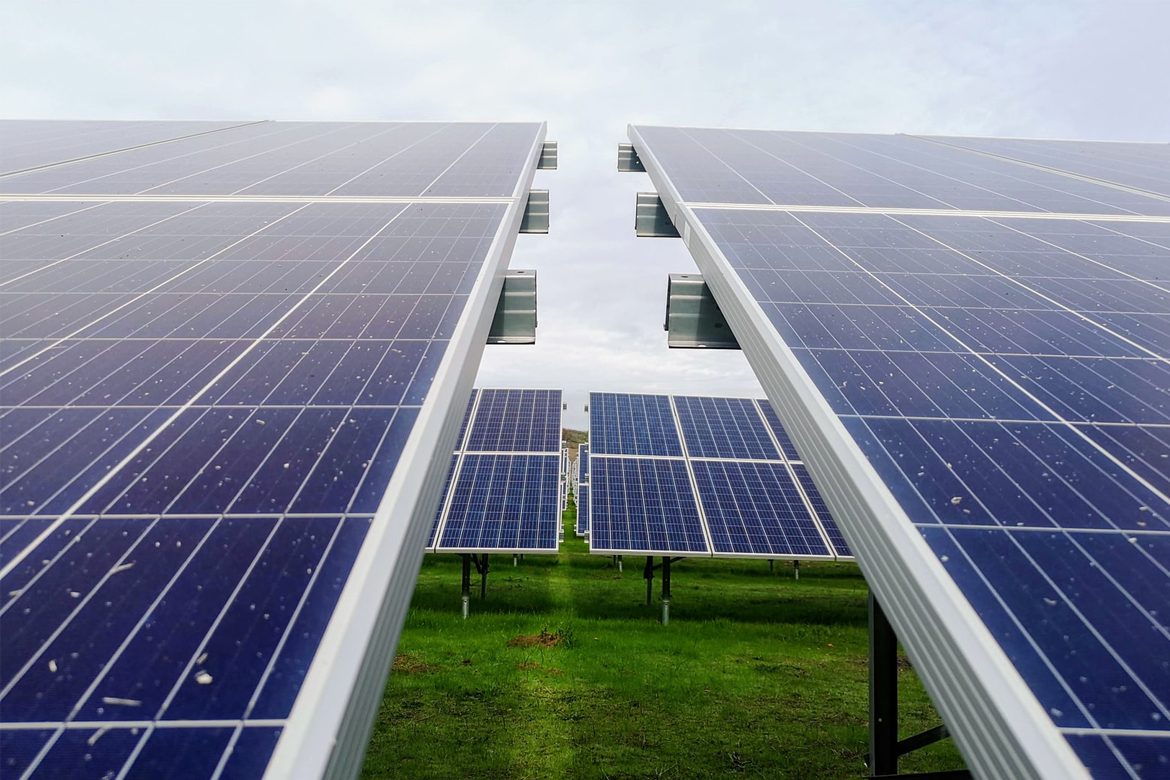
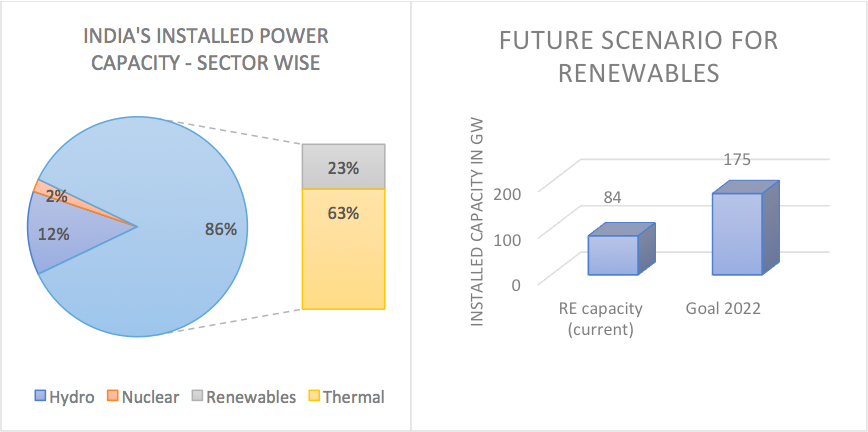
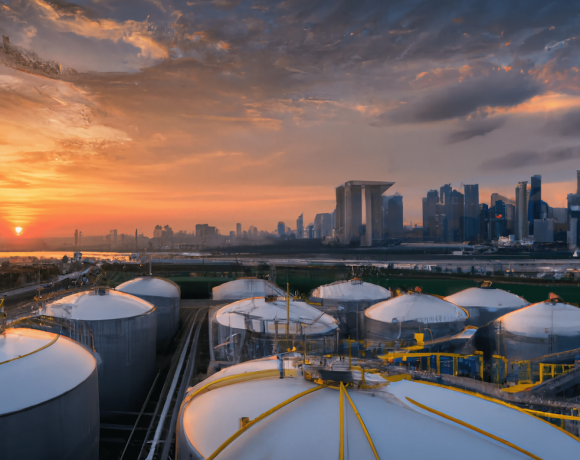

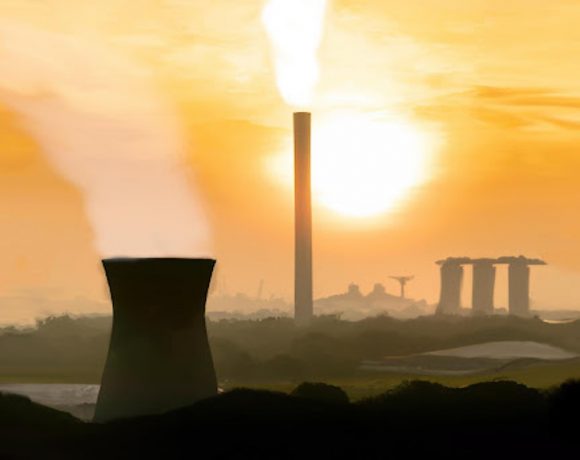

NO COMMENT